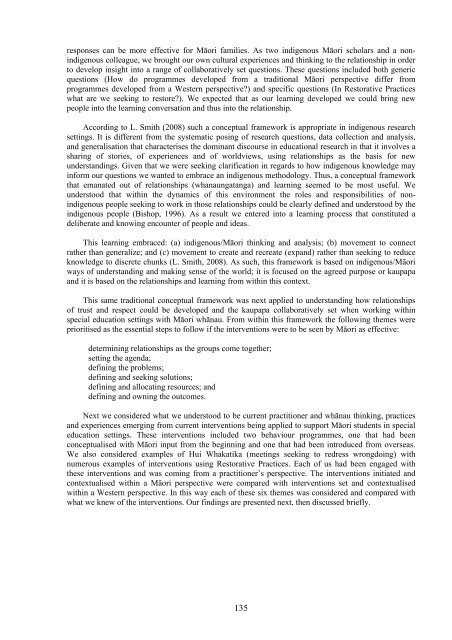traditional knowledge conference 2008 te tatau pounamu
traditional knowledge conference 2008 te tatau pounamu
traditional knowledge conference 2008 te tatau pounamu
Create successful ePaper yourself
Turn your PDF publications into a flip-book with our unique Google optimized e-Paper software.
esponses can be more effective for Māori families. As two indigenous Māori scholars and a nonindigenouscolleague, we brought our own cultural experiences and thinking to the relationship in orderto develop insight into a range of collaboratively set questions. These questions included both genericquestions (How do programmes developed from a <strong>traditional</strong> Māori perspective differ fromprogrammes developed from a Wes<strong>te</strong>rn perspective?) and specific questions (In Restorative Practiceswhat are we seeking to restore?). We expec<strong>te</strong>d that as our learning developed we could bring newpeople into the learning conversation and thus into the relationship.According to L. Smith (<strong>2008</strong>) such a conceptual framework is appropria<strong>te</strong> in indigenous researchsettings. It is different from the sys<strong>te</strong>matic posing of research questions, data collection and analysis,and generalisation that charac<strong>te</strong>rises the dominant discourse in educational research in that it involves asharing of stories, of experiences and of worldviews, using relationships as the basis for newunderstandings. Given that we were seeking clarification in regards to how indigenous <strong>knowledge</strong> mayinform our questions we wan<strong>te</strong>d to embrace an indigenous methodology. Thus, a conceptual frameworkthat emana<strong>te</strong>d out of relationships (whanaungatanga) and learning seemed to be most useful. Weunderstood that within the dynamics of this environment the roles and responsibilities of nonindigenouspeople seeking to work in those relationships could be clearly defined and understood by theindigenous people (Bishop, 1996). As a result we en<strong>te</strong>red into a learning process that constitu<strong>te</strong>d adelibera<strong>te</strong> and knowing encoun<strong>te</strong>r of people and ideas.This learning embraced: (a) indigenous/Māori thinking and analysis; (b) movement to connectrather than generalize; and (c) movement to crea<strong>te</strong> and recrea<strong>te</strong> (expand) rather than seeking to reduce<strong>knowledge</strong> to discre<strong>te</strong> chunks (L. Smith, <strong>2008</strong>). As such, this framework is based on indigenous/Māoriways of understanding and making sense of the world; it is focused on the agreed purpose or kaupapaand it is based on the relationships and learning from within this con<strong>te</strong>xt.This same <strong>traditional</strong> conceptual framework was next applied to understanding how relationshipsof trust and respect could be developed and the kaupapa collaboratively set when working withinspecial education settings with Māori whānau. From within this framework the following themes wereprioritised as the essential s<strong>te</strong>ps to follow if the in<strong>te</strong>rventions were to be seen by Māori as effective:de<strong>te</strong>rmining relationships as the groups come together;setting the agenda;defining the problems;defining and seeking solutions;defining and allocating resources; anddefining and owning the outcomes.Next we considered what we understood to be current practitioner and whānau thinking, practicesand experiences emerging from current in<strong>te</strong>rventions being applied to support Māori students in specialeducation settings. These in<strong>te</strong>rventions included two behaviour programmes, one that had beenconceptualised with Māori input from the beginning and one that had been introduced from overseas.We also considered examples of Hui Whakatika (meetings seeking to redress wrongdoing) withnumerous examples of in<strong>te</strong>rventions using Restorative Practices. Each of us had been engaged withthese in<strong>te</strong>rventions and was coming from a practitioner’s perspective. The in<strong>te</strong>rventions initia<strong>te</strong>d andcon<strong>te</strong>xtualised within a Māori perspective were compared with in<strong>te</strong>rventions set and con<strong>te</strong>xtualisedwithin a Wes<strong>te</strong>rn perspective. In this way each of these six themes was considered and compared withwhat we knew of the in<strong>te</strong>rventions. Our findings are presen<strong>te</strong>d next, then discussed briefly.135
















